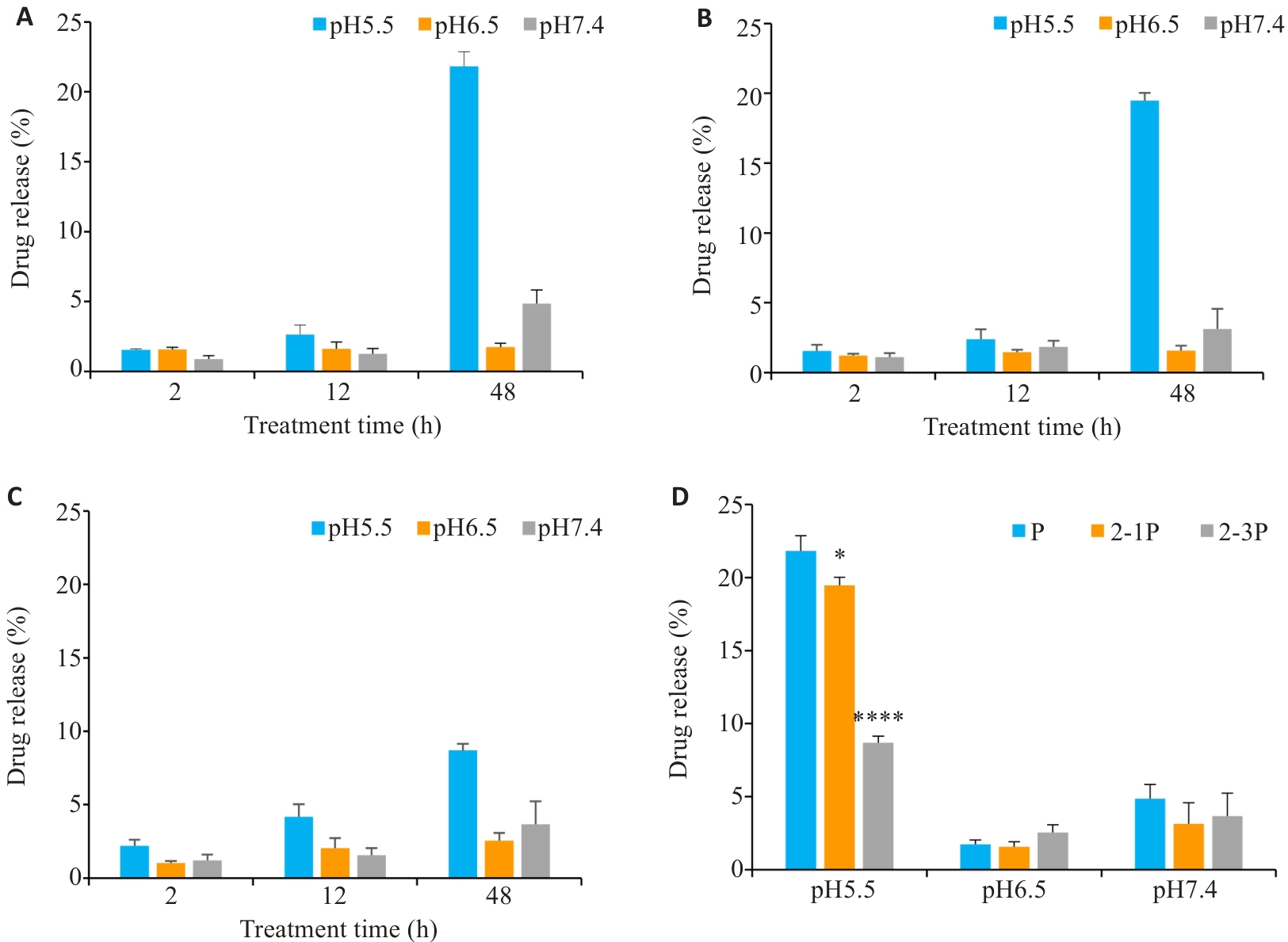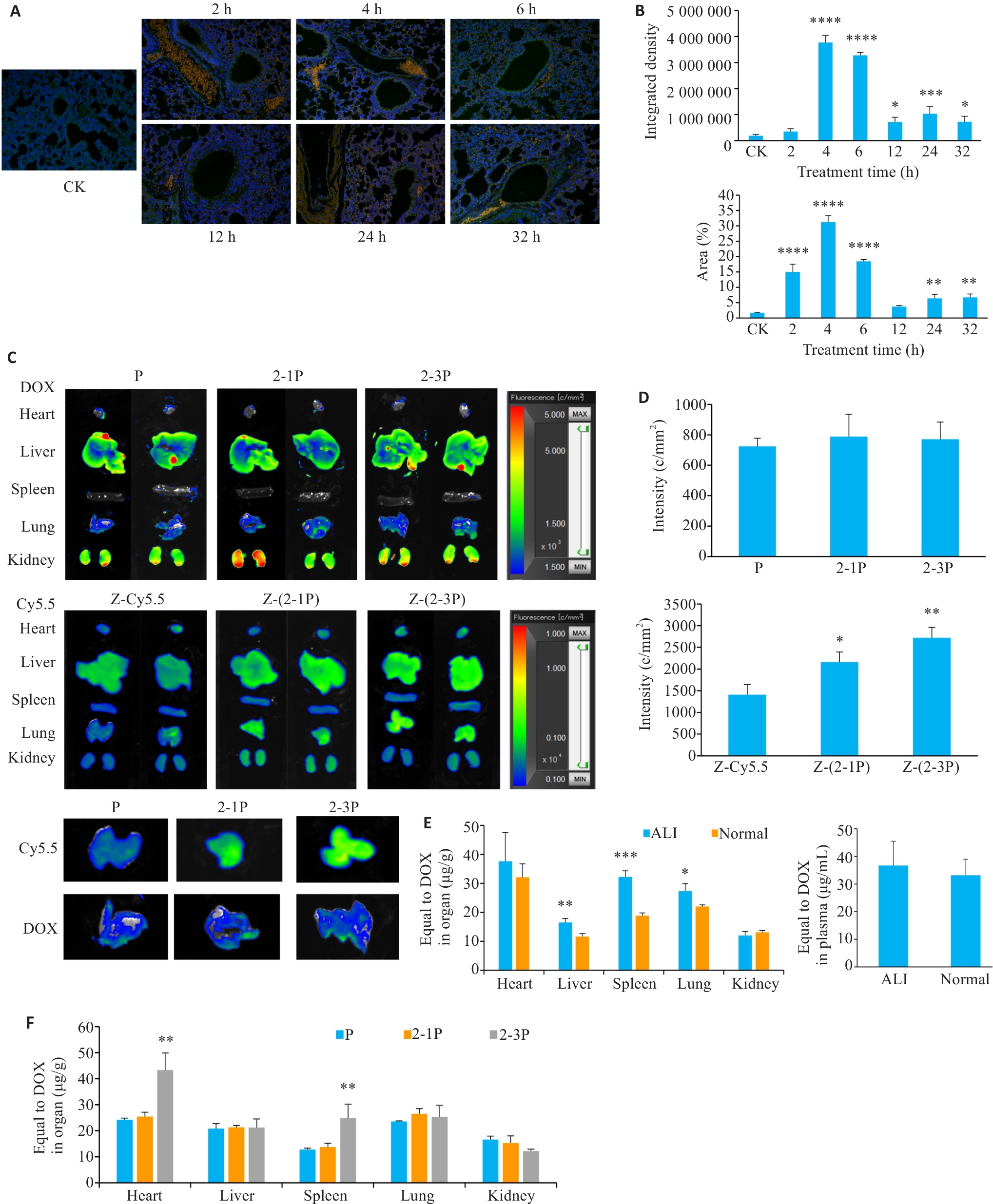Journal of Southern Medical University ›› 2025, Vol. 45 ›› Issue (5): 1013-1022.doi: 10.12122/j.issn.1673-4254.2025.05.14
Previous Articles Next Articles
Yumeng YE1( ), Bo YU3,4, Shasha LU1, Yu ZHOU1, Meihong DING1,2(
), Bo YU3,4, Shasha LU1, Yu ZHOU1, Meihong DING1,2( ), Guilin CHENG1,2(
), Guilin CHENG1,2( )
)
Received:2024-12-27
Online:2025-05-20
Published:2025-05-23
Contact:
Meihong DING, Guilin CHENG
E-mail:yeyumeng2024@163.com;dingmeihong0125@163.com;20151035@ zcmu.edu.cn
Supported by:Yumeng YE, Bo YU, Shasha LU, Yu ZHOU, Meihong DING, Guilin CHENG. Design and inflammation-targeting efficiency assessment of an engineered liposome-based nanomedicine delivery system targeting E-selectin[J]. Journal of Southern Medical University, 2025, 45(5): 1013-1022.
Add to citation manager EndNote|Ris|BibTeX
URL: https://www.j-smu.com/EN/10.12122/j.issn.1673-4254.2025.05.14
| Groups | Size (nm) | PDI | Zeta (mV) |
|---|---|---|---|
| Control | 93.84±1.96 | 0.11±0.01 | -1.66±0.41 |
| 2-1P | 81.36±0.28 | 0.08±0.05 | -25.30±0.40 |
| 2-3P | 83.21±0.52 | 0.04±0.03 | -23.87±0.12 |
Tab.1 Particle size, polydispersity index (PDI), and potential of modified liposomes for each formulation (n=3)
| Groups | Size (nm) | PDI | Zeta (mV) |
|---|---|---|---|
| Control | 93.84±1.96 | 0.11±0.01 | -1.66±0.41 |
| 2-1P | 81.36±0.28 | 0.08±0.05 | -25.30±0.40 |
| 2-3P | 83.21±0.52 | 0.04±0.03 | -23.87±0.12 |
| Groups | Moles of DPI (μmol) | Liposome's area (cm2) | DPI modification density (pmol/ cm2) |
|---|---|---|---|
| 2-1P | 0.04 | 8966.09 | 4.76 |
| 2-3P | 0.13 | 17718.10 | 7.57 |
Tab.2 Peptide modification density on liposome surface
| Groups | Moles of DPI (μmol) | Liposome's area (cm2) | DPI modification density (pmol/ cm2) |
|---|---|---|---|
| 2-1P | 0.04 | 8966.09 | 4.76 |
| 2-3P | 0.13 | 17718.10 | 7.57 |

Fig.1 Release profiles of each formulation at pH 5.5, pH 6.5, and pH 7.4. A: Cumulative release rate of PEGylated DOX liposomes (P) within 48 h. B: Cumulative release rate of 2-1P formulation of IEL-Lip/DOX within 48 h. C: Cumulative release rate of 2-3P formulation of IEL-Lip/DOX within 48 h. D: Release of the different formulations at different pH values after 48 h. *P<0.05, ****P<0.0001 vs P group.

Fig.2 In vitro targeting evaluation of IEL-Lip/DOX. A: Representative fluorogram images (×400) of E-selectin expression and DOX uptake in bEnd.3 inflammatory cells with different formulations of IEL-Lip/DOX. Green represents E-selectin labeling on the cell membrane, blue represents the DAPI-stained cell nucleus, and red represents DOX. B: Fluorogram (×400) of DOX uptake by HUVEC inflammatory cells. Blue represents the DAPI-stained cell nucleus, and red represents DOX. C: Flow cytometry analysis of DOX uptake by activated bEnd.3 and HUVEC cells in response to different formulations of liposomes (****P<0.0001 vs P group). D: Percentage bar chart of variables for drug penetration into the lower chamber in the Transwell simulating an invitro endothelial barrier model (**P<0.01 vs 2-3P group). P: Unmodified PEGylated DOX liposomes; 2-1P: IEL-Lip/DOX prepared in the ratio of Mol(PC): Mol(DPI)=100:1; 2-3P: IEL-Lip/DOX prepared in the ratio of Mol(PC): Mol(DPI)=100:3.

Fig.3 In vivo targeting efficiency of the prepared liposomes in mouse models of acute lung injury (ALI). A: Representative immunofluorescence images (×200) of E-selectin expression in lung tissue sections at different time points after LPS challenge. CK represents lung tissue sections from normal mice, green represents E-selectin labeling, and blue represents nuclear staining with DAPI. B: Quantitative plots of E-selectin immunofluorescence expression and positive area in lung tissue sections at different time points (*P<0.05, **P<0.01, ***P<0.001, ****P<0.0001 vs CK group). C: Representative tissue fluorescence images of ALI mice. D: Quantitative histogram of lung tissue fluorescence imaging in ALI mice. The upper panel shows DOX fluorescence intensity and the bottom panel shows Cy5.5 fluorescence intensity. (*P<0.05, **P<0.01 vs Z-Cy5.5 group, n=4). E: Comparison of DOX distribution in tissues and plasma after 2-1P injection in normal and ALI mice (*P<0.05, **P<0.01, ***P<0.001 vs Normal group, n=4). F: Quantification of tissue distribution of differently formulated liposomes in ALI mice (**P<0.01 vs P group, n=4).

Fig.4 In vivo targeting efficiency of the prepared liposomes in rat femoral artery physical injury inflammation model. A: Representative in vivo imaging fluorescence maps of femoral artery vasculature after injection of each formulation. B: DOX fluorescence intensity ratio of the injured side vessel to the normal side vessel for each formulation. *P<0.05 vs P group (n=4).
| 1 | Larsen GL, Henson PM. Mediators of inflammation[J]. Annu Rev Immunol, 1983, 1: 335-59. |
| 2 | Coffelt SB, Wellenstein MD, de Visser KE. Neutrophils in cancer: neutral no more[J]. Nat Rev Cancer, 2016, 16(7): 431-46. |
| 3 | Knight JS, Luo W, O'dell AA, et al. Peptidylarginine deiminase inhibition reduces vascular damage and modulates innate immune responses in murine models of atherosclerosis[J]. Circ Res, 2014, 114(6): 947-56. |
| 4 | Csepregi JZ, Orosz A, Zajta E, et al. Myeloid-specific deletion of mcl-1 yields severely neutropenic mice that survive and breed in homozygous form[J]. J Immunol, 2018, 201(12): 3793-803. |
| 5 | Barlogie B, Smith L, Alexanian R. Effective treatment of advanced multiple myeloma refractory to alkylating agents[J]. N Engl J Med, 1984, 310(21): 1353-6. |
| 6 | Alexanian R, Barlogie B, Tucker S. VAD-based regimens as primary treatment for multiple myeloma[J]. Am J Hematol, 1990, 33(2): 86-9. |
| 7 | Kansas GS. Selectins and their ligands: current concepts and controversies[J]. Blood, 1996, 88(9): 3259-87. |
| 8 | 付丽梅, 孙 青. E-选择素的研究进展[J]. 医学综述, 2008, 14(2): 185-7. DOI: 10.3969/j.issn.1006-2084.2008.02.010 |
| 9 | St Hill CA, Baharo-Hassan D, Farooqui M. C2-O-sLeX glyco-proteins are E-selectin ligands that regulate invasion of human colon and hepatic carcinoma cells[J]. PLoS One, 2011, 6(1): e16281. |
| 10 | Shirure VS, Henson KA, Schnaar RL, et al. Gangliosides expressed on breast cancer cells are E-selectin ligands[J]. Biochem Biophys Res Commun, 2011, 406(3): 423-9. |
| 11 | Belov L, Zhou J, Christopherson RI. Cell surface markers in colorectal cancer prognosis[J]. Int J Mol Sci, 2010, 12(1): 78-113. |
| 12 | Polley MJ, Phillips ML, Wayner E, et al. CD62 and endothelial cell-leukocyte adhesion molecule 1 (ELAM-1) recognize the same carbohydrate ligand, sialyl-Lewis x[J]. Proc Natl Acad Sci USA, 1991, 88(14): 6224-8. |
| 13 | Aldughaim MS, Muthana M, Alsaffar F, et al. Specific targeting of PEGylated liposomal doxorubicin (doxil®) to tumour cells using a novel TIMP3 peptide[J]. Molecules, 2020, 26(1): 100. |
| 14 | Balmaña M, Duran A, Gomes C, et al. Analysis of sialyl-Lewis x on MUC5AC and MUC1 mucins in pancreatic cancer tissues[J]. Int J Biol Macromol, 2018, 112: 33-45. |
| 15 | Fukuda MN, Ohyama C, Lowitz K, et al. A peptide mimic of E-selectin ligand inhibits sialyl Lewis X-dependent lung colonization of tumor cells[J]. Cancer Res, 2000, 60(2): 450-6. |
| 16 | Martens CL, Cwirla SE, Lee RY, et al. Peptides which bind to E-selectin and block neutrophil adhesion[J]. J Biol Chem, 1995, 270(36): 21129-36. |
| 17 | Sionov RV, Fridlender ZG, Granot Z. The multifaceted roles neutrophils play in the tumor microenvironment[J]. Cancer Microenviron, 2015, 8(3): 125-58. |
| 18 | Mantovani A, Cassatella MA, Costantini C, et al. Neutrophils in the activation and regulation of innate and adaptive immunity[J]. Nat Rev Immunol, 2011, 11(8): 519-31. |
| 19 | Scutera S, Musso T, Cavalla P, et al. Inhibition of human neutrophil functions in vitro by multiple sclerosis disease-modifying therapies[J]. J Clin Med, 2020, 9(11): 3542. |
| 20 | Dehghani T, Panitch A. Endothelial cells, neutrophils and platelets: getting to the bottom of an inflammatory triangle[J]. Open Biol, 2020, 10(10): 200161. |
| 21 | Bi YH, Duan WX, Chen J, et al. Neutrophil decoys with anti-inflammatory and anti-oxidative properties reduce secondary spinal cord injury and improve neurological functional recovery[J]. Adv Funct Mater, 2021, 31(34): 2102912. |
| 22 | O’Byrne PM, Metev H, Puu M, et al. Efficacy and safety of a CXCR2 antagonist, AZD5069, in patients with uncontrolled persistent asthma: a randomised, double-blind, placebo-controlled trial[J]. Lancet Respir Med, 2016, 4(10): 797-806. |
| 23 | Burmester GR, McInnes IB, Kremer JM, et al. Mavrilimumab, a fully human granulocyte-macrophage colony-stimulating factor receptor α monoclonal antibody: long-term safety and efficacy in patients with rheumatoid arthritis[J]. Arthritis Rheumatol, 2018, 70(5): 679-89. |
| 24 | Jaeger BN, Donadieu J, Cognet C, et al. Neutrophil depletion impairs natural killer cell maturation, function, and homeostasis[J]. J Exp Med, 2012, 209(3): 565-80. |
| 25 | Sharar SR, Winn RK, Murry CE, et al. A CD18 monoclonal antibody increases the incidence and severity of subcutaneous abscess formation after high-dose Staphylococcus aureus injection in rabbits[J]. Surgery, 1991, 110(2): 213-9, discussion219-20. |
| 26 | Basile DP. The endothelial cell in ischemic acute kidney injury: implications for acute and chronic function[J]. Kidney Int, 2007, 72(2): 151-6. |
| 27 | Molitoris BA, Sutton TA. Endothelial injury and dysfunction: role in the extension phase of acute renal failure[J]. Kidney Int, 2004, 66(2): 496-9. |
| 28 | Messer MP, Kellermann P, Weber SJ, et al. Silencing of fas, fas-associated via death domain, or caspase 3 differentially affects lung inflammation, apoptosis, and development of trauma-induced septic acute lung injury[J]. Shock, 2013, 39(1): 19-27. |
| 29 | Li S, Szymborski A, Miron MJ, et al. The adenovirus E4orf4 protein induces growth arrest and mitotic catastrophe in H1299 human lung carcinoma cells[J]. Oncogene, 2009, 28(3): 390-400. |
| 30 | Ehrhardt C, Kneuer C, Bakowsky U. Selectins-an emerging target for drug delivery[J]. Adv Drug Deliv Rev, 2004, 56(4): 527-49. |
| 31 | Liu Y, Yang BW, Zhao X, et al. E-selectin-binding peptide-modified bovine serum albumin nanoparticles for the treatment of acute lung injury[J]. AAPS PharmSciTech, 2019, 20(7): 270. |
| 32 | Ishibashi T, Kijima M, Yokoyama K, et al. Expression of cytokine and adhesion molecule mRNA in atherectomy specimens from patients with coronary artery disease[J]. Jpn Circ J, 1999, 63(4): 249-54. |
| 33 | Belch JJ, Shaw JW, Kirk G, et al. The white blood cell adhesion molecule E-selectin predicts restenosis in patients with intermittent claudication undergoing percutaneous transluminal angioplasty[J]. Circulation, 1997, 95(8): 2027-31. |
| 34 | Gotoh R, Suzuki JI, Kosuge H, et al. E-selectin blockade decreases adventitial inflammation and attenuates intimal hyperplasia in rat carotid arteries after balloon injury[J]. Arterioscler Thromb Vasc Biol, 2004, 24(11): 2063-8. |
| 35 | Bennett CM, Kanki JP, Rhodes J, et al. Myelopoiesis in the zebrafish, Danio rerio [J]. Blood, 2001, 98(3): 643-51. |
| 36 | Lieschke GJ, Oates AC, Crowhurst MO, et al. Morphologic and functional characterization of granulocytes and macrophages in embryonic and adult zebrafish[J]. Blood, 2001, 98(10): 3087-96. |
| 37 | 段秀英, 马瑞娇, 张 云, 等. 斑马鱼炎症模型及其在中药抗炎领域的应用[J]. 药物评价研究, 2021, 44(8): 1573-80. DOI: 10.7501/j.issn.1674-6376.2021.08.001 |
| 38 | Xu XL, Lu KJ, Zhu ML, et al. Sialic acid-functionalized pH-triggered micelles for enhanced tumor tissue accumulation and active cellular internalization of orthotopic hepatocarcinoma[J]. ACS Appl Mater Interfaces, 2018, 10(38): 31903-14. |
| No related articles found! |
| Viewed | ||||||
|
Full text |
|
|||||
|
Abstract |
|
|||||